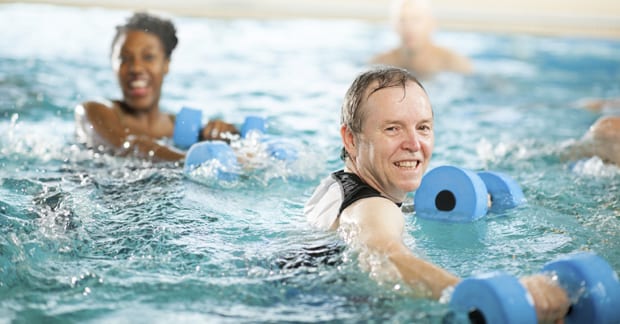Fibromyalgia (FM) is a chronic condition that gradually interferes with many aspects of one’s life. The challenge of treating FM is finding the right combination of approaches that positively impacts the structural, emotional, and chemical aspects of the body in such a way the FM patient can function "normally" when engaging in normal day-to-day activities. Exercise is one of the most important methods patients can use to successfully reach these goals.
First, because FM is a condition that is currently thought to affect the central nervous system where the threshold of reaching pain levels is lower than normal, pain is perceived when is shouldn’t normally be noticed. Therefore, the KEY to exercise integration is to start out SLOWLY and CONSISTENTLY. It is more important to work out in a way that muscles and joints can gradually acclimate to the new activity or movement. Many patients with FM are afraid to exercise for fear of hurting worse than they already do. In fact, many will report that, "…every time I exercise, I feel worse so I just don’t do it." When asked what types of exercises they’ve tried, it becomes clear it wasn’t the exercise but rather the dose or amount of exercise they engaged in (often overdoing it) that made the next 48-72 hours quite uncomfortable with post-exercise soreness.
Second, is to choose a type of exercise you enjoy so it's more likely you'll stick with it. Popular exercise options include yoga, Pilates, biking, swimming, and walking. These exercises can also be combined. For example, one might perform 15 minutes of yoga, followed by a 15-minute walk on a daily, consistent basis. The use of an exercise bike and/or a treadmill, stepper, or elliptical type of exercise equipment allows you to monitor heart rate, speed, and other data that allows you to compare yourself between sessions. Pick a time of day when you can be consistent with the exercises so you’re not "fitting it in" your busy daily schedule—make it part of your daily routine, similar to brushing your teeth or taking a shower. The morning or evening may work best but many find a noon-hour break a good time to exercise, as well.
Third, as you start to feel more in shape, gradually increase the intensity of the exercises. You may exercise for the same amount of time, say 30 minutes, but you’ll do a more intense work out such as walking faster, further, or increasing the pace of the yoga, Pilates, swimming, etc. Try not to be too intense (over aggressive) or do too little (under aggressive). You know your personality better than anyone else—hold yourself back if you tend to be overly aggressive or push yourself if you tend to be overly cautious. Expect the first 3-5 times you exercise to be challenging with associated post-exercise soreness but know you will adapt to the process.
The benefits of adding a well-designed, graduated exercise program include:
- Stronger ligaments, muscles, tendons and improved muscle tone.
- Increased flexibility.
- Increased blood flow to the muscle tissue.
- Increased endorphins (a morphine-like substance) that have a natural pain relieving and sleep deepening effect that can help curb anxiety, depression, as well as pain associated with FM.
- Reduced risk of high blood pressure, high cholesterol, diabetes, heart disease, and stroke.
- Weight loss/control which in turn, reduces stress on your muscles and joints.



